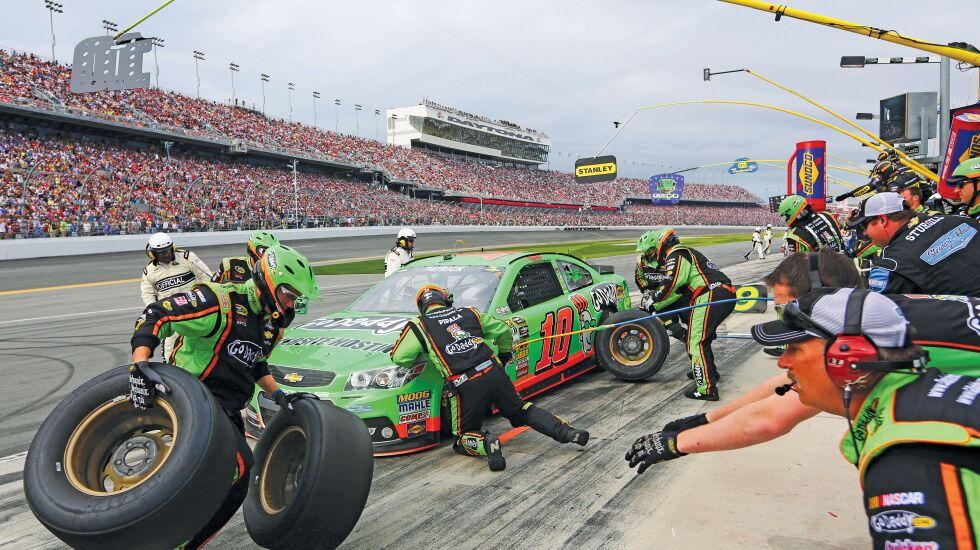
Having grown up in Roscoe, Illinois, and now maintaining a residence in Chicago, former race-car driver Danica Patrick is keenly aware of the effect that winter weather can have on roads. The cycles of freezing and thawing, plus de-icing treatments, can leave roads decimated.
But when NASCAR hosts its first street race July 1-2 in Chicago — a longtime victim of Old Man Winter — Patrick thinks road conditions will be the least of drivers’ worries.
“I’m sure the city of Chicago will make sure there’s no actual potholes where the track is,” Patrick said. “If there is any, they will be filled in.”
The course will wind drivers through downtown, taking them on Columbus Drive, DuSable Lake Shore Drive, Michigan Avenue and other streets. Street courses are more common in open-wheel racing, and Patrick competed on them in IndyCar, the Atlantic Championship and the defunct Barber Dodge series. So she knows what awaits the stock-car drivers.
“The track is very dirty and rough to start,” she said. “It almost feels like a carnival ride out there. You just don’t know what to expect, so get used to that. Also, just being able to see where you’re going can take a little time because it’s not wide-open spaces; it’s walls. There’s not a lot of room for error, so you have to be methodical if you don’t want to crash. If you’re not, then you might.
“Usually, just the beginning of the weekend is what feels kind of, ‘Oh, this is different.’ But once the track kind of rubbers in a little bit and cleans off, then you’re back to feeling like you’re just at a road course. The competition always ends up feeling like the same.”

Patrick drove in IndyCar and NASCAR from 2005 to 2018. In 2005, she became the first woman to lead the Indianapolis 500 (she led for 19 laps) and finished fourth. In 2008, she became the first woman to win a major-league open-wheel race, taking the IndyCar Series’ Indy Japan 300.
After switching to stock cars, she earned the pole for the 2013 Daytona 500, becoming the first woman to win a NASCAR Cup Series pole. She finished eighth, the best performance for a woman in the history of the race.
Patrick said open-wheel cars and stock cars react differently to street courses. She thinks NASCAR drivers should have it easier.
“Yes, it’s still an elite car and everything, but putting an IndyCar on the street versus a stock car on the street, I mean, a manhole cover can feel like a mountain in an IndyCar,” Patrick said. “But it probably won’t be quite as dramatic in a stock car because of the amount of ride-height gap between the bottom of the car and the road. Yes, the splitter and things like that still get as low as they can, but it’s not quite as sealed down to the ground. And it’s not as rigid. So I think it’s probably going to work out really well.”
Fun, but tiring
The weekend also includes concerts and activities, but in Patrick’s experience the drivers won’t have time for any of it, let alone a chance to enjoy Chicago.
“While being in a city is super-fun and cool and there’s things to do and restaurants and everything, you’re not really partaking in the fun stuff as a driver,” she said. “It’s not like you’re out hitting the best restaurants and bars. You’re not drinking. You’re eating and getting back to bed at a reasonable hour. You’re tired, usually.”

That’s similar to Patrick’s routine as a broadcaster, her role since retiring from racing. She has a 10-race schedule spanning the Formula One, IndyCar and NASCAR circuits, and she worked her fifth Indy 500 last month. (She won’t be at the Chicago race.) Although broadcasters have more freedom than drivers to soak in the scene, it’s not a lot more.
“The fun part about being done racing is that, to some degree, you can enjoy some of that stuff,” Patrick said. “But [when] I was in Miami for the F1 race doing that broadcast, I literally took a lunch, reheated it before I left the track and ate it on the bus home as dinner and just went back to the hotel.
“We weren’t in downtown Miami, but we were still in Miami enough to find good restaurants and have a good time. But I was so exhausted. When you’re working, it’s just totally different than when you’re there as a spectator.”
Patrick has been a natural on camera, but she has learned some valuable broadcasting lessons.
“Be concise,” she said. “When you’re a driver, [the interviewer wants you] to elaborate and tell stories and go into details. But as a host or an analyst, it’s much better to be concise. Another thing is to not always refer to myself. I’m in the position I’m in because I’m an expert in that field. I don’t need to necessarily justify that.”
If Patrick were in Chicago for the races, she’d know the hot spots. She still owns a condo in River North. Her permanent residence is in Scottsdale, Arizona, where she has an 8,300-square-foot mansion.

“Every time I go back, I think to myself, ‘I need to come here more,’ and then I don’t,” Patrick said of her Chicago trips. “And then every time I go back, I think the same thing, ‘I need to come here more.’ And then I don’t. It’s awesome [being there].”
The city and NASCAR hope spectators come away with the same feeling. The circuit hasn’t had a presence in the Chicago area since Chicagoland Speedway in Joliet lost its races in 2020 because of the pandemic and didn’t receive dates in 2021.
Patrick hopes the races have a lasting impact.
“I think it’s cool,” she said. “Street races are a great way to bring the race to people, and NASCAR is a great sport to bring to a street race.”







